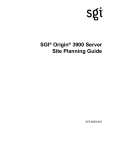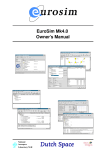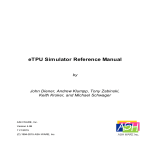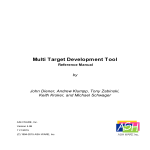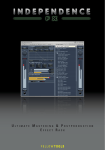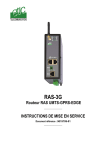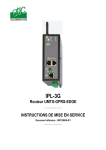Download SGI 2400 Technical data
Transcript
SGI™ Tensor Processing Unit (TPU) XIO Board Introduction Document Number 007-4222-002 CONTRIBUTORS Written by Heidi Racanelli Illustrated by Carlin Otto, Heidi Racanelli, and Sue Simet Edited by Mary Geisert and Allison Gosbin Production by Amy Swenson Engineering contributions by Larry Mueller, Tom Wieseler, Curt Egner, Dan Bieno © 1999 - 2000, Silicon Graphics, Inc.— All Rights Reserved The contents of this document may not be copied or duplicated in any form, in whole or in part, without the prior written permission of Silicon Graphics, Inc. RESTRICTED RIGHTS LEGEND Use, duplication, or disclosure of the technical data contained in this document by the Government is subject to restrictions as set forth in subdivision (c) (1) (ii) of the Rights in Technical Data and Computer Software clause at DFARS 52.227-7013 and/or in similar or successor clauses in the FAR, or in the DOD or NASA FAR Supplement. Unpublished rights reserved under the Copyright Laws of the United States. Contractor/manufacturer is SGI, 1600 Amphitheatre Pkwy, Mountain View, CA 94043-1351. SGI™ Tensor Processing Unit (TPU) XIO Board Introduction Document Number 007-4222-002 FCC Warning The equipment described in this guide has been tested and found compliant with the limits for a Class A digital device, pursuant to Part 15 of the FCC rules. These limits are designed to provide reasonable protection against harmful interference when the equipment is operated in a commercial environment. This equipment generates, uses, and can radiate radio frequency energy and, if not installed and used in accordance with the instruction manual, may cause harmful interference to radio communications. Operation of this equipment in a residential area is likely to cause harmful interference, in which case users will be required to correct the interference at their own expense. If this equipment does cause harmful interference to radio or television reception, which can be determined by turning the equipment off and on, the user is encouraged to try to correct the interference by one or more of the following measures: Reorient or relocate the receiving antenna. Increase the separation between the equipment and receiver. Connect the equipment into an outlet on a circuit different from that to which the receiver is connected. Consult the dealer or an experienced radio/TV technician for help. Caution: The user is cautioned that changes or modifications to the equipment not expressly approved by the party responsible for compliance could void the user’s authority to operate the equipment. For additional FCC information, refer to the Interference Handbook 1993 Edition prepared by the Federal Communications Commission. This booklet can be obtained by writing to the U.S. Government Printing Office, Superintendent of Documents, Mail Stop SSOP, Washington, D.C. 20402-9328, ISBN 0-16-041736-8. International Special Committee on Radio Interference (CISPR) This equipment has been tested to and is in compliance with the Class A limits per CISPR publication 22, Limits and Methods of Measurement of Radio Interference Characteristics of Information Technology Equipment. Canadian Department of Communications Statement This digital apparatus does not exceed the Class A limits for radio noise emissions from digital apparatus as set out in the Radio Interference Regulations of the Canadian Department of Communications standard NMB-003. SGI™ Tensor Processing Unit (TPU) XIO Board Introduction Document Number 007-4222-002 Attention Cet appareil numérique de la classe A est conforme a la norme NMB-003 du Canada. JAPAN - VCCI Class A Statement KOREA - Korea Class A Statement TAIWAN -CNS 13438 Class A Statement Manufacturer’s Regulatory Declarations This peripheral when integrated into the workstation conforms to several national and international specifications and European directives as listed on the “Manufacturer’s Declaration of Conformity,” which is included with each computer system. The CE insignia displayed on each device is an indication of conformity to the European requirements. Your peripheral has several governmental and third-party approvals, licenses, and permits. Do not modify this product in any way that is not expressly approved by Silicon Graphics, Inc. If you do, you may lose these approvals and your governmental agency authority to operate this device. SGI™ Tensor Processing Unit (TPU) XIO Board Introduction Document Number 007-4222-002 Silicon Graphics is a registered trademark and SGI and the SGI logo are trademarks of Silicon Graphics, Inc. IRIX and Onyx2 are registered trademarks and Gigachannel and Origin are trademarks of Silicon Graphics, Inc. SGI™ Tensor Processing Unit (TPU) XIO Board Introduction Document Number 007-4222-002 Contents Contents vii List of Figures ix TPU XIO Board Introduction 1 Part Verification 2 Maximum Number of TPU Boards 2 Power Requirements 2 Panel Plate and LEDs 3 Software Installation and Configuration Slot Selection 5 Startup 12 4 vii List of Figures Figure 1 Figure 2 Figure 3 Figure 4 Figure 5 Panel Plate and LEDs for the TPU XIO Board 3 I/O Items in the Origin 2000 Deskside Server 6 I/O Items in the Onyx2 Deskside Server 8 XIO Slots in Origin 200 Gigachannel Expansion Cabinet (Rackmount Rear) 9 I/O Items in Origin 2000 Rackmount, SGI 2400, and SGI 2800 Server Processor Module 11 ix 0. TPU XIO Board Introduction This document accompanies the SGI Tensor Processing Unit (TPU) XIO board and contains information about the TPU power requirements, panel plate and LEDs, software installation, and slot selection requirements for these Silicon Graphics chassis: • SGI Origin 2000 servers • SGI 2200, SGI 2400, and SGI 2800 servers • Silicon Graphics Onyx2 deskside systems • SGI Origin 200 Gigachannel servers The TPU is a high-performance, advanced digital signal processor. The TPU functions as a shared-memory coprocessor that improves time-to-solution for signal and image processing applications and related algorithms. The TPU is implemented as a Crosstalk I/O (XIO) board and uses mastered direct memory access to read and write data from and to the host node memory. XIO boards are optional products for Silicon Graphics platforms that are based on the scalable shared-memory multiprocessing (S2MP) architecture. Each active XIO slot provides up to 1.6 megabytes per second of bidirectional bandwidth (that is, 800 megabytes or 6.4 gigabits in each direction) through a crossbar switch that is located on the system's midplane. Specific XIO products may use either a portion or all of this available bandwidth. All of the XIO slots in a system can be active simultaneously. For more details on how XIO slots fit into the rest of the system, refer to each system’s installation or owner’s documents. SGI authorized service providers install TPU XIO boards into the host server, except in Origin 200 Gigachannel servers, which contain customer installable XIO boards. For Origin 200 Gigachannel XIO board installation instructions, refer to the Origin 200 and Origin 200 Gigachannel Maintenance Guide, publication number 007-3709-xxx. 1 TPU XIO Board Introduction Part Verification Open the XT-TPU-ORIGIN-1 box and verify that these components are included: • One SGI TPU XIO board in antistatic bag, part number 013-2590-xxx • One SGI Tensor Processing Unit (TPU) XIO Board Introduction, part number 007-4222-xxx (this document) Maximum Number of TPU Boards Table 1 summarizes the maximum number of TPU XIO boards that can be installed into the different chassis and systems. Table 1 Maximum Number of TPU XIO Boards That Can Be Installed System Per Node Board Per Chassis Origin 2000 deskside, SGI 2200 3 11 Origin 2000 rackmount, 3 SGI 2400, SGI 2800 11 per module with BaseIO installed or Onyx2 deskside 3 3 Origin 200 Gigachannel 3 3 12 per module Power Requirements Table 2 summarizes the power consumption for the TPU XIO board. Table 2 Power Requirements for TPU XIO Board Requirements Average 44 watts of power Maximum 5 volts at 2.7 amps, and 3.3 volts at 11.0 amps 2 Panel Plate and LEDs Unlike most XIO boards, the TPU XIO panel plate has no ports. It contains three round LEDs. During normal operation, these LEDs illuminate green. • 2.5 PWR: indicates that 2.5 voltage is supplied to the board. • 3.3 PWR: indicates that 3.3 voltage is supplied to the board. • LINK UP LED: indicates that communications have been established with the system. If a problem occurs with power or communications to the board, the LEDs illuminate amber. 3.3 LINK 2.5 PWR PWR UP LEDs 2.5 PW R 3.3 PW LIN R K UP 2.5 PWR LEDs 3.3 LINK PWR UP Figure 1 Panel Plate and LEDs for the TPU XIO Board Troubleshooting Suggestion If any LED fails to illuminate, ensure that the correct software is installed and configured; refer to “Software Installation and Configuration” on page 4. If any LED still does not illuminate, contact your SGI authorized service provider. 3 TPU XIO Board Introduction Software Installation and Configuration If your system is currently up and running, save yourself time and extra system reboots by installing and configuring the correct version of IRIX before the board is installed. Follow the instructions below: 1. Verify that IRIX 6.5.5 or greater is installed: % versions eoe I eoe I eoe.sw.base date IRIX Execution Environment, version... date IRIX Base Execution Environment If these IRIX software subsystems are not installed or if the displayed version is earlier than 6.5.5, reinstall IRIX from the CD (or other source). 2. Verify that the IP27 PROM revision is 6.25 or greater: % hinv -mv | grep IP27prom IP27prom in Module 1/Slot n1: Revision 6.25 IP27prom in Module 1/Slot n2: Revision 6.25 3. Become superuser: % su Password: 4. Edit the /var/sysgen/system/irix.sm file to change the TPU lines from EXCLUDE to INCLUDE: * * Tensor Processing Unit support. * INCLUDE: tpu INCLUDE: tpuidbg INCLUDE: tpusim DRIVER_ADMIN: tpu_ XBAR_CREDITS=3 DRIVER_ADMIN: tpusim_ NDEV=144 5. Enable large page sizes and remove the page lock limit with the following commands: # systune percent_totalmem_16m_pages 20 # systune percent_totalmem_256k_pages 20 # systune maxlkmem 0 6. Run the autoconfig command to build a new operating system (kernel) that includes the new driver: # autoconfig 4 Slot Selection Follow the instructions in this section to select an appropriate XIO slot. • “Slot Selection Rules for Origin 2000 Deskside and SGI 2200 Servers” on page 5 • “Slot Selection Rules for Onyx2 Deskside Systems” on page 7 • “Slot Selection Rules for Origin 200 Gigachannel Servers” on page 9 • “Slot Selection Rules for Origin 2000 Rackmount, SGI 2400, and SGI 2800 Servers” on page 9 Slot Selection Rules for Origin 2000 Deskside and SGI 2200 Servers Each node board accommodates a maximum of 3 TPU cards. In general, if an server has a node board in slot N1 or N3 with BaseIO in XIO slot 1, then XIO slots 2–6 are available (shown in Figure 2). If it has a node board in slot N2 or N4, XIO slots 7–12 are available. If a module has at least two node boards, one in N1 or N3 and one in N2 or N4, then XIO slots 2–12 are available. (For servers with 2 or more nodes, refer to Table 3 for the recommended slot order of installation.) 5 TPU XIO Board Introduction Upper panel plate containment bar slot 9 slot 11 slot 1 slot 3 slot 5 slot 7 Midplane Compression connector on midplane I/O cage Middle card guide Compression connector on board BaseIO XIO board Filler panel t2 4 slo slot t 6 8 sloslot 0 t 1 12 slo s l o t XIO board Lower panel plate containment bar Rear of Module Figure 2 6 I/O Items in the Origin 2000 Deskside Server Slot Selection Rules for Onyx2 Deskside Systems Each Onyx2 node board accommodates a maximum of 3 TPU cards. The Onyx2 deskside system has 6 XIO slots. Slots 3, 5, and 6 (shown in Figure 3) are available for TPU XIO boards. It is recommended that you fill available odd-numbered slots before filling even-numbered ones, and that you fill lower-numbered slots before higher-numbered ones. For example, fill slot 3 before filling either slot 5 or slot 6. Note: Do not use Onyx2 XIO slots 2 or 4 for the XIO TPU card. 7 TPU XIO Board Introduction Midplane O) seI Ba ( t1 s l o lot 3 5 s t slo Upper panel plate containment bar Compression connector for slot 5 Middle card guide Lower card guide BaseIO ) Blank panel ble usa able) t plates for ( no t us t6 o t2 slo slot 2 sl o t 4 ( n slo Figure 3 8 I/O Items in the Onyx2 Deskside Server Lower panel plate containment bar Slot Selection Rules for Origin 200 Gigachannel Servers The Origin 200 Gigachannel expansion cabinet has 5 XIO slots, which are numbered 11–15. A maximum of 3 of the 5 XIO slots are available for TPU cards; no restrictions exist on which 3 of the 5 slots you select. Retaining plate Figure 4 XIO slots XIO Slots in Origin 200 Gigachannel Expansion Cabinet (Rackmount Rear) Slot Selection Rules for Origin 2000 Rackmount, SGI 2400, and SGI 2800 Servers 1. If you are installing the board into a system of interconnected racks, determine the rack into which you will install the board. 2. Within the selected rack, determine which module (that is, the upper or the lower) you are going to work on. 3. Determine which XIO slots in the selected module are usable. Figure 1 illustrates the XIO slots in a processor module. Depending on the number of Node boards, the count of usable XIO slots in a module can be 6 or 12. In modules that require the BaseIO board, XIO slots 2–6 or 2–12 are available. 9 TPU XIO Board Introduction The server installation instructions provide information that can help you determine which of the slots are activated. Note: In general, if a module has a Node board in slot N1 or N3, then XIO slots 1-6 are available. If it has a Node board in slot N2 or N4, XIO slots 7-12 are available. If a module has at least two Node boards (one in N1 or N3 and one in N2 or N4), then all 12 XIO slots are available. 4. Select a slot for the TPU XIO board. This board can be installed in any of the XIO slots–including slots 1 and 2 (illustrated in Figure 5)–that are designed to accommodate the BaseIO and Internal PCI Adapter options. Refer to Figure 5. When you select a slot for the TPU board, fill available odd-numbered slots before filling even-numbered slots, and fill lower-numbered slots before higher-numbered slots. For servers with 2 or more nodes, refer to Table 3 for the recommended slot order of installation. Table 3 Installing TPU Boards to Equalize Bandwidth and Control (Two or More Nodes) Order of Installation Start Loading XIO Slots Node Board that Controls the XIO Slot 10 First XIO Board IO1 Nodes 1 and 3 Next XIO Board IO7 Nodes 2 and 4 Next XIO Board IO4 Nodes 1 and 3 Next XIO Board IO8 Nodes 2 and 4 Next XIO Board IO3 Nodes 1 and 3 Next XIO Board IO9 Nodes 2 and 4 Next XIO Board IO6 Nodes 1 and 3 Next XIO Board IO10 Nodes 2 and 4 Next XIO Board IO5 Nodes 1 and 3 Next XIO Board IO11 Nodes 2 and 4 Next XIO Board IO12 Nodes 2 and 4 Final XIO Board IO2 Nodes 1 and 3 slot 1 slot 3 slot 5 slot 7 slot 9 slot 11 Midplane Upper panel plate containment bar Compression connector on midplane I/O cage Middle card guide Compression connector on board BaseIO XIO board Filler panel t2 4 slo slot t 6 8 sloslot 0 t 1 12 slo s l o t XIO board Lower panel plate containment bar Rear of Module Figure 5 I/O Items in Origin 2000 Rackmount, SGI 2400, and SGI 2800 Server Processor Module 11 TPU XIO Board Introduction Startup When the board is installed and connected, follow the instructions in this section to start operation. 1. Power on the system. Follow the appropriate power-on instructions for the system's configuration. 2. Log on. 3. Verify that the three LEDs on the board illuminate green. If any LED fails to illuminate, ensure that the correct software is installed and configured; refer to “Software Installation and Configuration” on page 4. If any LED still does not illuminate, contact your SGI authorized service provider. 4. Verify that the board was located by the operating system during the bootup: %hinv | grep Tensor External Tensor Processing External Tensor Processing External Tensor Processing External Tensor Processing External Tensor Processing External Tensor Processing External Tensor Processing External Tensor Processing External Tensor Processing Unit, Unit, Unit, Unit, Unit, Unit, Unit, Unit, Unit, module module module module module module module module module 1 1 1 1 1 1 1 1 1 slot slot slot slot slot slot slot slot slot 11 8 10 7 9 4 6 5 3 The number after module and slot should correctly identify the chassis and XIO slot into which you installed the board. There will be other lines in this display; however, verify the line that corresponds to the board you installed. Note: Device directories that correspond to the TPUs installed in the system reside in /hw/tpu. Additionally, the TPU requires the device directory /hw/tpu/any. 12






















